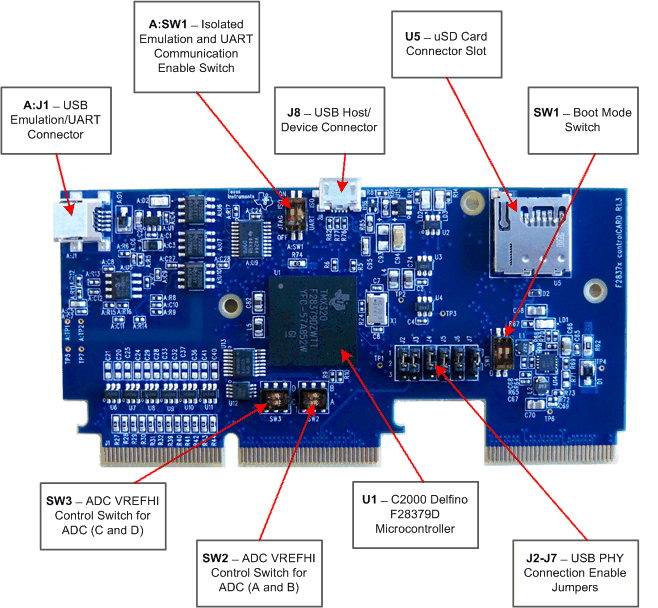SPRUI76B March 2017 – June 2022 TMS320F28379D , TMS320F28379D-Q1
5 Hardware References
Table 5-1 shows the various connections available on the board. Figure 5-1 illustrates the location of many of these components on the board.
When the controlCARD is used in a high-voltage setup, it is the user’s responsibility to confirm that the voltages and isolation requirements are identified and understood prior to energizing the board or simulation. When energized, the controlCARD or components connected to the controlCARD should not be touched. Furthermore, the capacitor A:C31 should be removed to minimize the possibility of leakage current flowing across the isolation barrier of the controlCARD.
 Figure 5-1 Key components on the controlCARD
Figure 5-1 Key components on the controlCARD| Connectors | ||||
| A:J1 | Emulation/UART connector - USB mini A connector used to provide xds100v2 emulation and USB-to-UART(SCI) communication through FTDI logic. A:SW1 determines which connections are enabled to the MCU. | |||
| U5 | SD Micro card slot – connects to MCU via SPI | |||
| J8 | USB connector – USB micro AB connector supports USB 2.0 host/device | |||
| J9 | Enables a secondary board to have access to the F28379D’s EMIF2 and several other digital signals. | |||
| Jumpers | ||||
| J2-J7 | USB PHY connection enable/disable jumpers: | |||
|
||||
| LEDs | ||||
| LD1 | Turns on when the controlCARD is powered ON (green) | |||
| LD2 | Controlled by GPIO-31 with negative logic (red) | |||
| LD3 | Controlled by GPIO-34 with negative logic (red) | |||
| A:D2 | Turns on when ISO JTAG logic is powered on (green) | |||
| A:D3 | JTAG/UART RX toggle indicator (blue) | |||
| A:D4 | JTAG/UART TX toggle indicator (blue) | |||
| Resistors and Capacitors | ||||
| R59, R60 | Alternate Reference Configuration Resistors | |||
| These resistors allow the user to choose whether the alternate reference for the ADCs will be given by: | ||||
|
||||
| R27-R50 and C18-C41 | Optional RC input filter for all ADC inputs | |||
| Switches (default position in BOLD) | ||||
| SW1 | Boot Mode Switch: | |||
| Controls the
Boot Options of the F28379D device. For more
information. (0 is down, 1 is up), see the
device-specific data sheet. Mode # Switch Position 1 (GPIO-72) Switch Position 2 (GPIO-84) Boot from 00 0 0 Parallel I/O 01 0 1 Boot from SCI 02 1 0 Wait Boot Mode 03 1 1 Get Mode (Flash by default) |
||||
| Mode # | Switch
Position 1 (GPIO-72) |
Switch
Position 2 (GPIO-84) |
Boot from | |
| 00 | 0 | 0 | Parallel I/O | |
| 01 | 0 | 1 | Boot from SCI | |
| 02 | 1 | 0 | Wait Boot Mode | |
| 03 | 1 | 1 | Get Mode (Flash by default) | |
| SW2 | ADC VREFHI Control Switch for ADC modules A & B: | |||
Switch 1
(lower switch) – VREFHI Control Switch for ADC
module A:
|
||||
Switch 2 (upper switch) – VREFHI Control Switch
for ADC module B:
|
||||
| SW3 | ADC VREFHI Control Switch for ADC modules C & D: | |||
Switch 1
(lower switch) – VREFHI Control Switch for ADC
module C:
|
||||
Switch 2
(upper switch) – VREFHI Control Switch for ADC
module D:
|
||||
| A:SW1 | Isolated emulation and UART communication enable switches: | |||
Switch
Position 1 – JTAG Enable:
|
||||
Switch
Position 2 – ISO UART communication enable:
|
||||